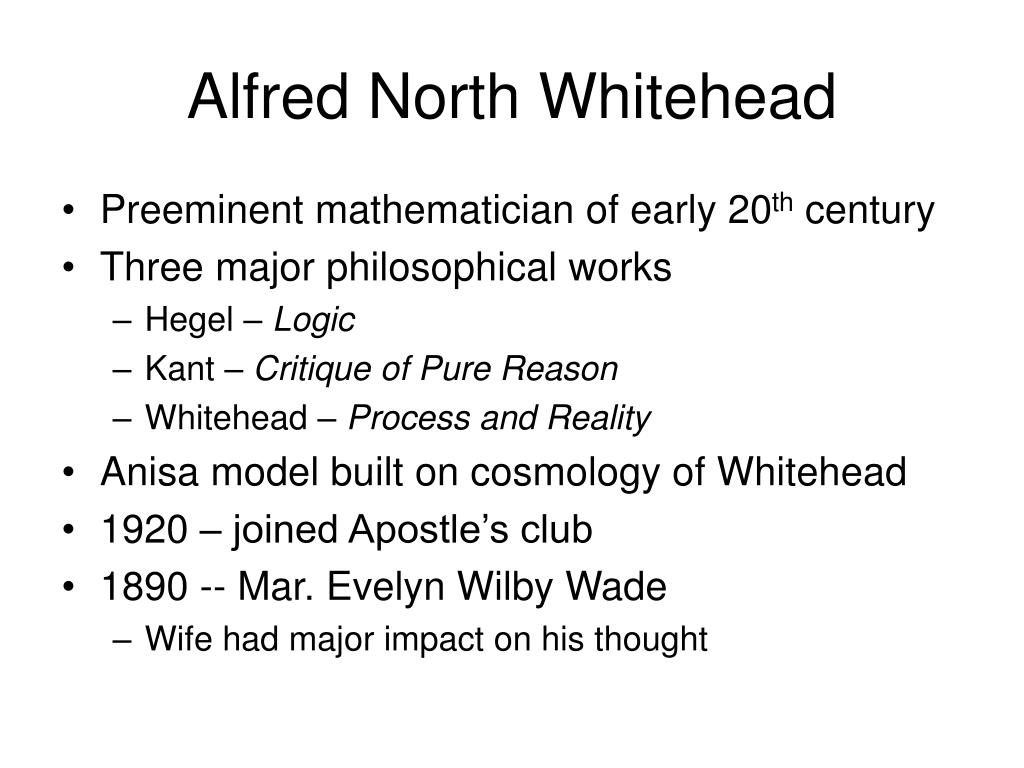
Both terms are abstractions of the concrete reality of ‘mind existing at the basic level of ‘matter’.This Aristotelian notion is replaced by the notion that attributes are everything (the substance is the reification of the attributes).An object is part of the subject: the perception of an object is part of the process that is that object.Understanding the universe as a thriving interwoven mesh of processes leads to the rejection of many purported dichotomies – the fusion of opposites (and thus their resolution). For example:.For Whitehead, even the physical, spatio-temporal nature of our epoch may change.(There is possibly also a theological origin of this belief (God as eternal and setting eternal laws, mixed with Plato’s influence on Christianity).).We commit the fallacy of generalizing from the particular when we believe that the regularities (processes) of nature we observe at our timescale are eternal laws of nature (David Hume makes the same point with his Problem of Induction). A so-called ‘ constant’ of nature is also an abstraction for Whitehead.process) in order to identify them as such. Whitehead says that notions such as momentum, direction of motion, and wave type become meaningless in such an abstracted instant.Thus, if we ask what ‘something’ is at an ‘instant’ we will never receive a proper answer. A process is temporal, the notion of an ‘ instant’ (t 1, t 2, etc.) is an also an abstraction.

Perception operates in the relation part-to-whole rather than representation-to-object.Therefore one’s perception of the star is part of the star (and part of you).a “star” enters into your eye and brain the star’s process becomes part of you. The Principle of Relativity: a part of a process continues into another process (and thus becomes part of that other process).This difference affects the placing of subjectivity.) (But note the importance of differentiating aggregates from systemic processes: e.g.It is more parsimonious to claim that matter includes mind at all levels (‘panexperientialism’), rather than that matter ‘produces’ mind at complex levels (which, as we saw, ends in problems of supervenience, emergence, upward and downward causation, etc.). For Whitehead, even the concept of ‘matter-energy’ is an abstraction.For Whitehead, a process is not merely a flux of ‘matter-energy’ but also such that includes sentience(s).Everything is in flux, permanence is merely an illusion of timescale. As Nietzsche put it (when discussing Heraclitus), if we observed nature at different time scales, we could see trees pop up and wither away, the sun could look like a ‘luminous bow across the sky’ contrariwise at slower speeds, we could observe a flower as being as permanent as a mountain.Even so-called ‘enduring objects’ (mountains, moons, etc.) are processes, as can be understood over time.It is also affected by surrounding bodies that constitute it. a ‘star’ is not only the spherical ‘object’ but also the light emitted therefrom throughout the universe. A process can have a centre of operation, but it extends spatio-temporally into its environment – thus it is a part of its environment (and the environment is a part of it).

Electromagnetism is an example of the fundamental basis of flux. We often think that a process must involve at the base level ‘things’ changing (such as water molecules in wave processes), but this is not necessary.Processes are not ‘things’ changing, but ‘things’ are movements abstracted.our language solidifies what is in actuality flux. This fallacy is perhaps induced by our Indo-European linguistic emphasis on nouns (rather than verbs). Henri Bergson)), and an effect of the Fallacy of Misplaced Concreteness: reification – we easily slip into believing that an individual word/term must refer to an individual object (e.g. The belief in individual objects is an effect both of our evolved perceptual apparatus, notably vision (we perceive relatively isolated objected for practical purposes (cf.

an “atom” does not exist as an isolated substance with essential and accidental properties, but is rather an abstraction that denotes a temporal process consisting of myriad elements constantly in flux, those elements also constituting other processes.


 0 kommentar(er)
0 kommentar(er)
